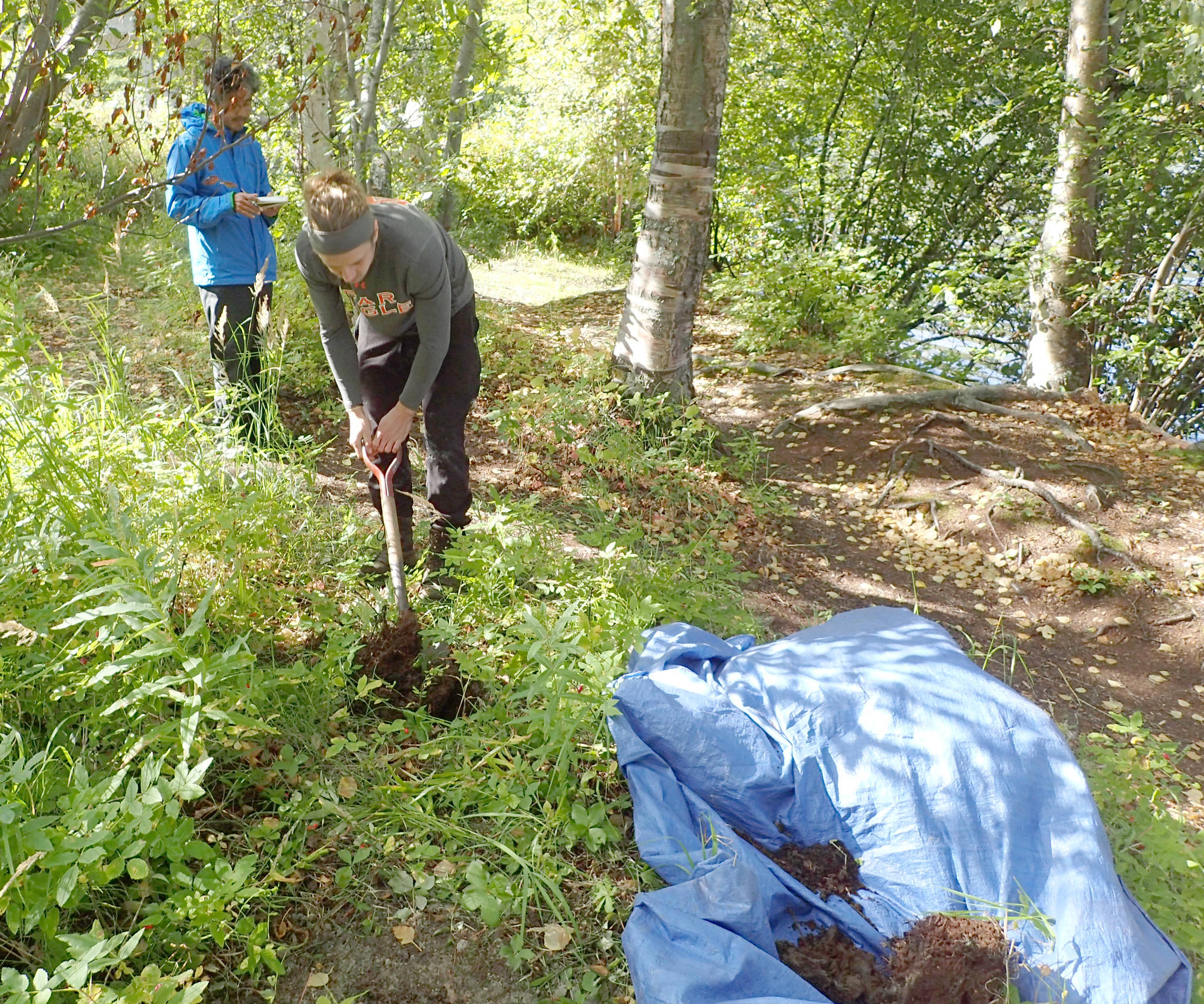This last September we hosted two earthworm experts from the University of Minnesota, Dr. Kyungsoo Yoo and graduate student Adrian Wackett. They study how earthworms alter soils in the American Midwest and in Northern Europe, working in places where exotic earthworms have been around for a long time. The Kenai Peninsula offered these scientists a chance to study recent, actively spreading earthworm invasions.
They chose to work at Stormy Lake in Nikiski, where night crawlers were dumped near the public boat launch. Night crawlers make vertical burrows and feed on surface litter, changing soils more dramatically than any other exotic earthworm species introduced to our area.
Adrian and Dr. Yoo remarked they had never seen such abundant night crawlers as what was found at Stormy Lake. Their earthworm biomass numbers were twice as high as the highest number I found in a quick search of online studies.
Using their data, I estimated there were 1,300 pounds of earthworms per acre at Stormy Lake! To put that in perspective, consider that a 1,300-pound moose needs about 500 acres in good habitat.
We wondered why they might grow so numerous here. Our best explanation was that these worms might be flourishing because of a bountiful food supply of leaf litter with little competition from other worm species.
We also witnessed a new phenomenon. As the night crawlers invaded new areas, they actually buried the leaf litter layers with mineral soil brought up from below. This was strange to see. In areas with older infestations where night crawlers had more time to multiply, they had eaten all of the litter and humus layers.
You have likely heard it said that earthworms improve garden soils, and this is true. Cultivated plants generally do benefit from the activities of earthworms – but not everyone in the larger ecological community wins.
Exotic earthworms have caused a range of problems in other parts of northern North America. By fundamentally changing the structure and properties of soils through their feeding, introduced earthworms have led to declines in native plants, fungi and animals that depend on a thick layer of leaf litter.
Ferns, orchids and shrews, for example, tend to do poorly where earthworms occur, while grasses and exotic plants do better. Over time, earthworms can even change which trees repopulate the forest by altering seed and seedling survival.
Thankfully, night crawlers remain absent from most of the Kenai Peninsula. On the Kenai National Wildlife Refuge, we have found night crawlers exclusively at a few boat launches, the result of what is termed “bait abandonment.”
On their own, night crawlers spread more slowly than most glaciers move. It would take more than 500 years for them to make their way around the shore of Stormy Lake.
Robins and other birds could transport earthworms, but it is unlikely that night crawlers could be spread very far this way. Night crawlers sexually reproduce, which means robins would have to drop multiple live night crawlers in the same vicinity to start a new population.
Even if this did occur, robins tend to bring food only short distances, so dispersal by birds would not contribute much to the big picture of how night crawlers get around. Earthworms can disperse a little faster when they are washed down streams, but almost all of their long-range dispersal has been by people.
Should we try to keep night crawlers and other potentially deleterious worms from being spread around by people?
In Canada and some areas of the northern United States, organizations and governmental entities have sought to prevent the spread of invasive earthworms through outreach programs, trying to change people’s behavior by educating the public about problems caused by exotic earthworms.
Voyageurs National Park in Minnesota prohibits live bait partly to prevent the spread of invasive earthworms. These public education efforts and regulations may reduce the long-range spread of exotic earthworms, but people have continued to transport earthworms to new areas.
Last fall, Dr. Yoo and Adrian found a new population of night crawlers on the refuge at Hidden Lake, apparently another instance of “bait abandonment.” The area infested was only 15 feet wide and surrounded by refuge lands currently free of night crawlers. If we could, should we remove these worms before they spread any farther into the surrounding forest?
I have begun looking into whether this is even possible. After the advent of synthetic pesticides and industrial agriculture, agronomists discovered that some pesticides commonly used on crops had the unintended side effect of killing earthworms.
Recently, the aviation industry has started to ask how to reduce earthworm populations to keep worm-eating birds from being attracted to runways. Now it is the golf industry that is leading research into earthworm control. Turf managers have identified several candidate methods that knock down earthworm populations and reduce their undesirable casts on golf courses.
Airport and golf course settings, where the object is merely to reduce worm populations for a time, differ from ours, where the purpose would be eradication. Here, where night crawlers arrived only recently, we still have a chance to conserve naturally diverse and naturally functioning forest ecosystems.
To the best of my knowledge, no one anywhere in the world has attempted to completely remove an earthworm population, even a small, new infestation. Is there a situation where this would make sense? Is this something we should be pursuing?
Matt Bowser serves as Entomologist at Kenai National Wildlife Refuge. Find more Refuge Notebook articles (1999–present) at https://www.fws.gov/refuge/Kenai/community/refuge_notebook.html.

